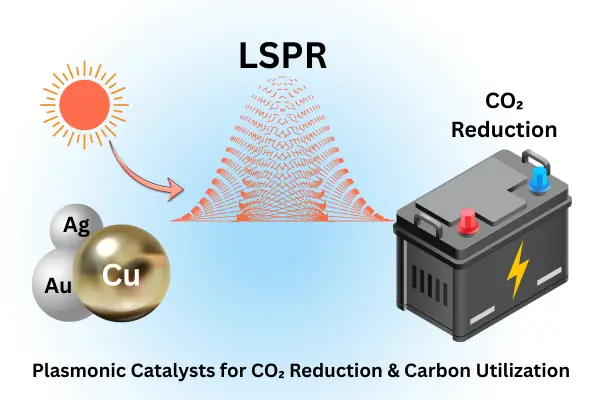The global push towards carbon neutrality has accelerated research into advanced catalytic systems that can convert CO₂ into valuable fuels and chemicals. Among the many emerging strategies, plasmonic catalysts for photo-thermal CO₂ reduction are gaining significant attention from researchers, students, professors, and industry experts alike. This article explores the fundamentals, mechanisms, and recent breakthroughs in this exciting field.
What Are Plasmonic Catalysts?
Plasmonic catalysts leverage localized surface plasmon resonance (LSPR), a phenomenon observed in noble metal nanoparticles (such as gold, silver, and copper). When these nanoparticles interact with light, collective oscillations of free electrons are induced, leading to strong absorption of visible and near-infrared light.
This optical excitation generates energetic charge carriers (hot electrons and holes) and localized heating effects. Both processes can significantly enhance catalytic reactions, making plasmonic nanomaterials highly attractive for CO₂ reduction.[1]
The Role of Photo-Thermal Effects in CO₂ Reduction
Photo-thermal catalysis has emerged as a promising strategy for efficient CO₂ reduction, leveraging plasmonic nanostructures to convert incident photons into localized heat. This dual mechanism combining photonic excitation with thermal energy provides significant catalytic advantages. [2] First, localized heating lowers the activation energy, thereby accelerating reaction kinetics and enhancing overall conversion rates. Second, the generation and transfer of hot carriers, particularly hot electrons, into adsorbed CO₂ molecules facilitates bond activation and promotes more efficient electron-driven reduction processes. Third, by engineering nanoparticle parameters such as size, morphology, and composition, researchers can precisely tune reaction selectivity, enabling the targeted production of valuable fuels and chemicals including carbon monoxide (CO), methane (CH₄), and methanol. This integration of light-driven and thermal effects positions photo-thermal catalysis as a scalable, high-performance pathway for sustainable carbon dioxide utilization.[3]
Mechanism of Plasmonic Catalysts
The mechanism of plasmon-enhanced CO₂ reduction is governed by a synergistic interplay of optical, electronic, and thermal effects unique to metallic nanostructures.[4] Upon photon absorption, localized surface plasmons are excited, producing intense near-field effects and initiating dynamic charge processes. These charge dynamics generate hot electrons and holes, which rapidly relax and can be injected into adsorbed CO₂ intermediates, lowering the energy barriers for bond activation. Concurrently, localized heating provides thermal enhancement, accelerating reaction kinetics, facilitating C=O bond cleavage, and promoting efficient product desorption. This multi-modal activation pathway differentiates plasmonic catalysts from conventional photocatalysts, which rely primarily on semiconductor band-gap excitation, thereby offering superior selectivity and efficiency for sustainable CO₂ conversion into value-added fuels and chemicals.[5]
Recent Advances in Plasmonic CO₂ Reduction
Significant progress has been made in leveraging plasmonic nanostructures to enhance CO₂ reduction performance. Bimetallic systems, particularly Au–Cu and Ag–Cu nanostructures, have shown superior CO₂ adsorption capabilities and improved product selectivity compared to their monometallic counterparts.[6] Hybrid architectures that integrate plasmonic metals with semiconductors such as TiO₂ and ZnO have been especially effective in promoting charge separation, thereby improving overall catalytic efficiency.[7] At the same time, nanostructure engineering through the fabrication of anisotropic geometries like nanorods and nanostars has expanded light absorption across broader spectral ranges, maximizing photon utilization. Complementing these material innovations, operando spectroscopic techniques now enable real-time tracking of reaction intermediates, providing critical mechanistic insights that guide the rational design of next-generation plasmonic catalysts.
Applications
For industry, the scalability of plasmonic catalysts is a key challenge. While lab-scale results are promising, large-scale synthesis and long-term stability remain hurdles. However, their ability to use sunlight directly makes them attractive for decentralized CO₂-to-fuel conversion technologies.
Solar-Driven Fuel Production : Solar-driven fuel production uses plasmonic and photo-thermal catalysts to directly convert CO₂ into energy-dense fuels using sunlight. This approach provides a renewable pathway to generate carbon-neutral energy carriers, reducing reliance on fossil fuels and enabling large-scale integration of solar energy into the global energy mix.[8]
- On-Site CO₂ Recycling in Chemical Plants : On-site CO₂ recycling allows chemical plants to capture and reuse their own emissions as feedstocks, creating closed-loop carbon cycles. By integrating catalytic CO₂ conversion systems, industries can lower greenhouse gas emissions while simultaneously producing valuable intermediates for chemicals and fuels.[9]
- Sustainable Methanol Synthesis for the Energy Sector : Methanol synthesized from captured CO₂ using solar-driven processes is a sustainable energy carrier and industrial feedstock. It can be used directly as a clean fuel, blended into existing energy infrastructure, or converted into hydrogen, supporting the energy sector’s transition toward low-carbon, renewable-based systems.[10]
Future of Plasmonic Catalysts
The convergence of nanophotonics, catalysis, and advanced materials science is opening new frontiers in CO₂ utilization. Current research efforts are directed toward the development of earth-abundant plasmonic materials, such as aluminum-based nanostructures, which provide a cheaper and more sustainable alternative to traditional noble-metal systems.[11] Parallel work is focused on improving the stability and resilience of catalysts under the harsh conditions typically encountered in CO₂ reduction reactions, a critical step toward practical scalability. In addition, the integration of artificial intelligence and machine learning is accelerating the rational design of nanostructures, enabling the optimization of catalytic activity and selectivity with unprecedented precision. Together, these approaches signal a transformative pathway for advancing CO₂ conversion technologies.[12]
Why Choose Nikalyte for Plasmonic Catalysts
Nikalyte benchtop nanoparticle system is ideal for creating plasmonic metal catalysts, such as gold (Au), silver (Ag), and copper (Cu) nanoparticles, thanks to its precise control over size, composition, and deposition in a clean, ultra-high vacuum environment.[13] The NL UHV nanoparticle deposition source allows the formation of high-quality bimetallic nanostructures like Au–Cu and Ag–Cu, which exhibit increased light absorption, localized surface plasmon resonance (LSPR) tuning, and improved charge carrier dynamics, which are critical for accelerating photocatalytic reactions like photo-thermal CO₂ reduction. Nikalyte’s NL UHV nanoparticle deposition source ensures reproducibility and scalability, making it an excellent choice for developing advanced plasmonic catalysts for sustainable carbon utilization.[14]
Conclusion
Plasmonic catalysts in photo-thermal CO₂ reduction represent a cutting-edge intersection of nanotechnology and sustainable chemistry. By coupling light and heat at the nanoscale, these systems offer unique pathways to convert greenhouse gases into value-added chemicals. For students, researchers, and industry professionals, mastering this domain could unlock transformative technologies for a carbon-neutral future.
Reference
- da Silva, A. G. M., Rodrigues, T. S., Wang, J., & Camargo, P. H. C. (2022). Plasmonic catalysis with designer nanoparticles. Chemical Communications, 58(13), 2055–2074. https://doi.org/10.1039/D1CC03779J
- Zhao, S.-H., Wang, H.-B., Li, Q., Ding, H., Qian, C., Wang, Q., Li, H.-Y., Jiang, F., Cao, H.-J., Li, C.-H., & Zhu, Y.-Y. (2023). Photothermal catalysis in CO₂ reduction reaction: Principles, materials and applications. Journal of Energy Chemistry, 75, 186-204. https://doi.org/10.1016/S1872-5805(23)60722-X
- Zhang, F., Li, Y.-H., Qi, M.-Y., Yamada, Y. M. A., Anpo, M., Tang, Z.-R., & Xu, Y.-J. (2021). Photothermal catalytic CO₂ reduction over nanomaterials. Chem Catalysis, 1(2), 272–297. https://doi.org/10.1016/j.checat.2021.01.003
- Wang, T., Wang, H.-J., Lin, J.-S., Yang, J.-L., Zhang, F.-L., Lin, X.-M., Zhang, Y.-J., Jin, S., & Li, J.-F. (2023). Plasmonic photocatalysis: Mechanism, applications and perspectives. Chinese Journal of Structural Chemistry, 41(10), 100066. https://doi.org/10.1016/j.cjsc.2023.100066
- Kong, T., Liao, A., Xu, Y., Qiao, X., Zhang, H., Zhang, L., & Zhang, C. (2024). Recent advances and mechanism of plasmonic metal–semiconductor photocatalysis. RSC Advances, 14, 17041–17050. https://doi.org/10.1039/D4RA02808B
- Huang, J., Dai, J., Zhu, J., Chen, R., Fu, X., Liu, H., & Li, G. (2022). Bimetallic Au-Cu gradient alloy for electrochemical CO₂ reduction into C₂H₄ at low overpotential. Journal of Catalysis, 415, 134–141. https://doi.org/10.1016/j.jcat.2022.09.033
- Manuel, A. P., & Shankar, K. (2021). Hot electrons in TiO₂–noble metal nano-heterojunctions: Fundamental science and applications in photocatalysis. Nanomaterials, 11(5), 1249. https://doi.org/10.3390/nano11051249
- Luo, S., Ren, X., Lin, H., Song, H., & Ye, J. (2021). Plasmonic photothermal catalysis for solar-to-fuel conversion: Current status and prospects. Chemical Science, 12, 5701–5719. https://doi.org/10.1039/D1SC00064K
- Barecka, M. H., Ager, J. W., & Lapkin, A. A. (2021). Carbon neutral manufacturing via on-site CO₂ recycling. iScience, 24(6), 102514. https://doi.org/10.1016/j.isci.2021.102514
- Zhang, P., Chen, Q., Chen, H., Geng, L., Wu, H., Chen, Z., Cao, J., Qi, D., & Ma, Y. (2025). A new transportation energy review: Methanol catalytic synthesis from CO₂ green hydrogenation. Renewable and Sustainable Energy Reviews, 57, 115819. https://doi.org/10.1016/j.rser.2025.115819
- Zhou, L., Zhang, C., McClain, M., Manjavacas, A., Krauter, C., Tian, S., Berg, F., Everitt, H., Nordlander, P., & Halas, N. (2016). Aluminum nanocrystal as a plasmonic photocatalyst for hydrogen dissociation. Nano Letters, 16(2), 1080–1085. https://doi.org/10.1021/acs.nanolett.5b05149
- Fusco, Z., & Beck, F. J. (2024). Advances in fundamentals and application of plasmon-assisted CO₂ photoreduction. Nanophotonics, 13(4), 387–417. https://doi.org/10.1515/nanoph-2023-0793
- Benchtop nanoparticle deposition system. Nikalyte. https://www.nikalyte.com/pvd-systems/benchtop-nanoparticle-deposition-system/
- Nanoparticle deposition source NL UHV. Nikalyte. https://www.nikalyte.com/nanoparticle-deposition-source-nl-uhv/


